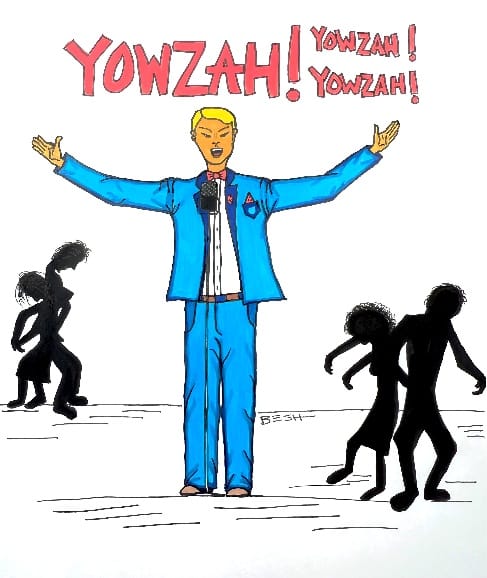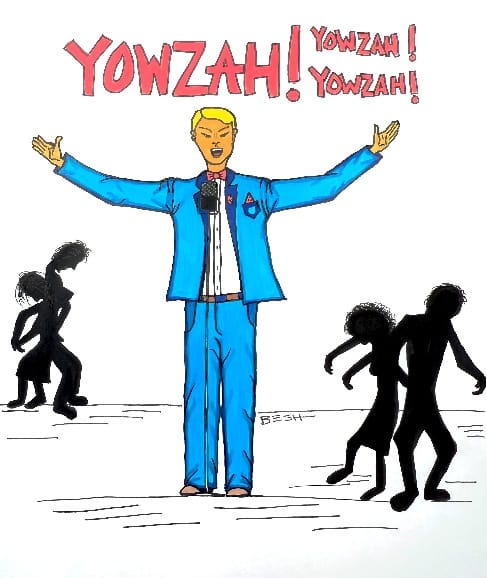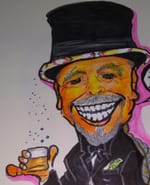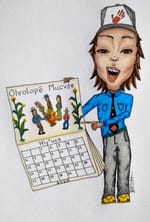
By Fus Yvhikv
Before the Blaxploitation films of the 1970s (Shaft, where have you gone?), before the Hagsploitation movies of the 1960s (here’s to you Baby Jane) there was real life “Paupersploitation”. The sadistic exploitation of the poor, the hungry, and the homeless is the leitmotif of the film, They Shoot Horses, Don’t They?
In a dystopian juxtaposition, dancing is the instrument of torture. It is a brilliant, if Machiavellian, invention by director Sydney Pollack predicated upon Horace McCoy’s 1935 novel. In the case of Horses, however, “dancing” includes weeks and even months of Zombie-like shuffling, inhumane derby races, tossing comatose contestants into a freezing ice bath, and dragging a dead man across the finish line. Have you no decency, sir?
Under Pollack’s astute directorship “They Shoot Horses, Don’t They?” accurately captures the zeitgeist of 1930s Depression-era Los Angeles. The movie manifests the grinding poverty, hunger, desperation, and hopelessness of Hollywood’s proletariat. These shells of humanity teeter on the precipice of death. Their grip on life so tenuous the burden of a fly on their shoulders might well finish them off.
The plot centers around a dance marathon. The entire movie takes place in a tiny arena resembling a small-town roller-skating rink. The dimly lit arena is as bleak and sparse as the lives of the dance competitors. The dark setting establishes an air of grimness that permeates 1930s L.A.
Robert Syverton (Michael Sarrazin) is a broke aspiring film director. He wanders into a dance marathon about to begin in a shabby ballroom on the Santa Monica pier. Rocky (Gig Young) is the contest’s promoter and emcee. Rocky recruits Robert to the contest and pairs him with Gloria Beatty (Jane Fonda). Gloria is a failed actress who is bitter, world weary, deeply cynical, and devoid of hope.
Other notable characters include Ruby, a pregnant Okie and her husband James, Alice an aspiring actress desperate to be discovered, and Sailor, an aging man whose ambition is more than his heart can handle.
These desperate souls come together to pursue the $1,500 grand prize ($35,000 in today’s dollars). Perhaps even more so, they hope to be spotted by Hollywood celebrities and talent scouts in the audience. No matter this forlorn hope of discovery is about as likely as a sway back mule winning the Triple Crown. However, grit, determination, and perseverance against all odds is the American way. At least according to Hollywood.
And that is the gist of Horses; it is a commentary on the illusions of Hollywood. The dreams of making it big versus the stark reality the great majority of dreamers never make it. And the message of Horses is the system is stacked against the dreamers and the hopeful.
The paramount scene in the movie comes during the third act. There the promoter, Rocky, one thousand hours into the marathon, attempts to convince Robert and Gloria to get married as a PR stunt so as to drive more ticket sales. Rocky callously tells the recalcitrant couple, “You can get divorced afterwards if you want.” When Gloria flatly refuses a shocked Rocky replies, “It’s just business! Strictly business!” Anything for show business, right?
Like Satan tempting Jesus, Rocky tries to seduce Gloria with the promise of wedding gifts that the couple could hawk for $200-$300. To which Gloria replies, “Yeah, well, what if we win?”
Rocky’s face takes on a telling, downcast, and resigned expression. He then reveals the fix is in. Rocky informs Gloria the expenses of conducting the dance marathon will be deducted from the $1,500 first place prize. This will leave the winner with nothing. The compassionless fly has just landed on Gloria’s slumping shoulders.
Defeated at the marathon and resigning from life, Gloria pleads with Robert to put her out of her misery. She hands him a pistol. Robert requires no convincing to pull the trigger. When the police ask him why he shot Gloria, he meekly replies, “They Shoot Horses, Don’t They?”
The acting in these scenes, as throughout the movie, is superb. Sarrazin’s eyes express a wide range of emotions. Indeed, nonverbal communications and acting in Horses is first rate. Director Pollack susses out memorable performances from his cast. Gig Young as Rocky is a likeable and charismatic villain and he won an Academy Award as Best Supporting Actor for this role.
Horses is first and foremost an allegory and critical commentary on a Hollywood system that eats its young and puts its’s old out to pasture. But the movie also has pronounced psycho drama dimensions. In particular, the film is an illustration of man’s inhumanity to man with its motif of sadistic dancing.
Dance marathons became popular in America during the Roaring Twenties. In the spirit of the times, America was partying like it was 1899. These 1920s dance marathons were another way of having fun and good times. The marathons were typically overnight affairs. Generally, they were organized and conducted by small, local nonprofit groups as fundraisers.
As the Roaring Twenties gave way to the Great Depression the dance marathons took a sinister turn. Professional promoters begin to organize the dances which lasted weeks and even months. Typically, the dancers were given only ten minutes each hour to rest or catch what little sleep they could get. Thus, the “dances” became grueling tests of endurance. Audiences flocked to the contests in the sadistic hope of enjoying the growing misery of the contestants.
The events became an unvarnished schadenfreude of the spectators. In contemporary times they may be likened to NASCAR races where the attendees hope to see fiery and deadly car wrecks. Many have opined regarding this phenomenon. Times were extremely tough for the great majority during the Depression. One school of thought is that these unfortunate people attended the dances just to see others who were worse off than them. Many of the dancers were homeless itinerants. They competed not so much for the promised prize money but for food and shelter. Sadistic dancing thus became a popular spectator sport during the crucible of the Great Depression.
Emcee Rocky attempts to establish a veneer of respectability on the sadistic dancing by repeatedly crowing that the dancers were fed eight times a day. Why, many of the dancers actually put on weight, he enthusiastically announces! And they receive 24/7 medical care despite the questionable qualifications of the so-called medical staff. Male contestants were tossed into a freezing ice bath so as to wake them from their slumber and continue their near-death shuffling. The ice baths became a fan favorite. Yowzah! Yowzah! Yowzah!
They Shoot Horses, Don’t They? manifests strong echoes of the movie Chinatown. The emcee, Rocky, is a Noah Cross-like figure. Rocky holds all the cards, and his true motivation is hidden from the contestants. He manipulates the dancers like chess pieces. And in the end, he gets away with it. Like Chinatown, there is no happy ending. In so doing, Director Pollack delivers a crisp right cross to the shit-eatin’ grin of Hollywood.
Man’s inhumanity to man seems both eternal and universal. So too does the phenomenon of people take joy and delight in the misery of others. We can’t wait for the next sadistic dancing marathon. Oh, the exquisite joy of watching the zombies as they pas de deux. Bring it on! Yowzah! Yowzah! Yowzah!








